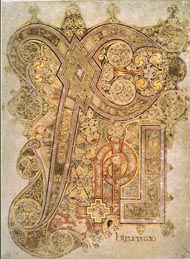

As part of our discussion of the Book of Kells, we will contemplate the famous Chi-Rho page from the Book of Kells. Spend time looking at it. See how much you can find. Can you find cats feeding kittens? Do you find angels? What about a moth or butterfly?
|
|

|
 |
This page marks the incipit or beginning of the 18 verse of Matthew I. The text reads: "XPI autem generatio...." The text of this verse in the Douay Rheims translation reads:
Now the generation of Christ was in this wise.When as his mother Mary was espoused to Joseph, before they came together, she was found with child of the Holy Ghost.
Like other Hiberno-Saxon gospel books, notably the Lindisfarne Gospels, this text is given prominence. It almost serves as a second incipit for the Book of Matthew which begins with the Latin incipit: "Liber generationis Iesu Christi..." or in the Douay Rheims translation: "The book of the generation of Jesus Christ, the son of David, the son of Abraham...."
The reason for this prominence can be connected to the importance of the doctrine of the "Incarnation," which literally means "into flesh." The first 17 verses of the book of of Matthew recounts the earthly ancestry of Christ back to Abraham, while verse 18 marks the point of the Incarnation of Christ in the book of Matthew, the first of the Gospels in the manuscript. Remember that the text of the manuscript is written on parchment or animal skin. So that this page is literally "the word made flesh," echoing the beginning of the book of John:
In the beginning was the Word, and the Word was with God, and the Word was God.... 14 And the Word was made flesh, and dwelt among us, (and we saw his glory, the glory as it were of the only begotten of the Father,) full of grace and truth.
This text captures how the Book of Kells and this page would be experienced by a monk using this book in the liturgy.
Our experience of contemplating this page can be compared to the monastic experience of contemplating on the nature of Christ. Compare for example the following famous description of an Hiberno Saxon Gospel manuscript, perhaps the Book of Kells itself, written by the 12th century monk, Gerald of Canterbury (Topographia Hiberniae (1185)):
"This book contains the harmony of the four Evangelists
according to St. Jerome, where for almost every page there are
different designs, distinguished by varied colors. Here you may
see the face of majesty, divinely drawn, here the mystic symbols
of the Evangelists, each with wings, now six, now four, now two;
here the Eagle, there the Calf, here the Man, and there the Lion,
and other forms almost infinite. Look at them superficially with
the ordinary casual glance, and you would think it an erasure,
and not tracery. Fine craftsmanship is all about you, but you
might not notice it. Look more keenly at it, and you will penetrate
to the very shrine of art. You will make out intricacies, so delicate
and subtle, so exact and compact, so full of knots and links,
with colors so fresh and vivid, that you might say that all this
was the work of an angel, and not of a man. For my part the oftener
I see the book, and the more carefully I study it, the more I
am lost in ever fresh amazement, and I see more and more wonders
in the book."
To the following text written by Claudius of Turin describing the monastic experience of meditating on the Gospels:
"I published three books [on Genesis] from the sayings
of the holy Fathers concerning the letter and the spirit... For
the word came into the world by Mary, clad in flesh; and seeing
was not understanding; all saw flesh; knowledge of the divinity
was given to a chosen few. So when the Word was shown to men through
the lawgiver and the prophets, it was not shown them without suitable
vesture. There it is covered by the veil of flesh, here of the
letter. The letter appears as flesh; but the spiritual sense within
is known as divinity. This what we find in studying Leviticus...
Blessed are the eyes which see divine spirit through the letter's
veil."
|
f. 33: Carpet page |